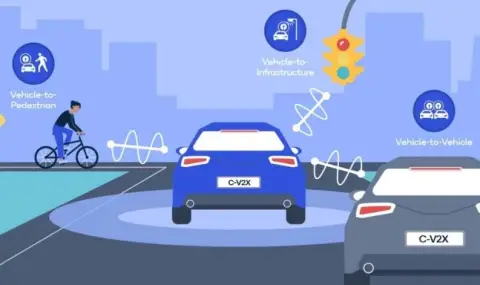In the next five years, the US Department of Transportation wants all automakers to equip your vehicles with a new generation of anti-collision systems. These vehicles will be able to see other cars and turns. After the American manufacturers, this solution will be integrated by the European and Asian car companies.
The details
The plan aims to accelerate the deployment of a new generation of vehicle safety technologies that experts say could prevent hundreds of thousands of crashes each year and improve traffic efficiency.
Thanks to these systems, vehicles will be able to quickly and continuously communicate with each other and with the roadside infrastructure. They operate at greater distances than current collision avoidance systems, as well as bypass physical barriers such as buildings and other cars and warn drivers much earlier of danger - such as a sudden stop in front of you, poor road conditions or another vehicle that will go through a red light.
The US National Highway Traffic Safety Administration (NHTSA) estimates that just two features of the new C-V2X system - left turn assist and cross traffic alert - could prevent 615,000 crashes and save more than 1,300 lives every year.
But the large-scale deployment of C-V2X devices is a complex process that will take more than two decades and requires automakers, device manufacturers and a long list of government agencies to overcome a number of technical hurdles and agree on a universal standard for data exchange between cars.
„This is the highest security measure. I think we're done. I'm just curious when consumers will actually learn about it and want to install it in their cars, “ says Debra Bezzina, executive director of the Center for Connected and Automated Transportation at the University of Michigan.
What is C-V2X?
Most modern cars are equipped with collision avoidance systems that rely on a combination of radar, cameras and laser sensors to detect when other vehicles in the immediate vicinity are slowing down or changing direction. Depending on the manufacturer, they notify drivers of the danger with a warning light, an audible signal or in some other way. These systems are good at detecting danger in close proximity, but are limited by line of sight.
Vehicles equipped with the C-V2X device will be equipped with cellular communication systems that transmit data in the low-latency 5.9 gigahertz band that the US Federal Communications Commission has reserved specifically for this purpose.
Every tenth of a second, the systems will send packets of data on location, dimensions, speed, direction of travel and other safety information to all other cars in the vicinity and to roadside transmitters. Thus, even in the absence of direct visibility, the systems can communicate with each other at a distance of at least 300 meters, which means that the driver will be notified of a danger much earlier than now and the car will have more time to stop.
Although C-V2X systems do not require cellular networks to communicate between devices, they operate under the same 3GPP standards that govern cellular communications. In areas with mobile coverage, this means systems can be networked to collect and transmit real-time information about wider traffic patterns.
However, there is one problem
This expansion of communication capabilities creates a number of cybersecurity and privacy issues. To prevent tampering or redirection of driver tracking communications, the Department says C-V2X will use a secure authentication system built on a public-key infrastructure.
Each C-V2X device will receive a series of pseudonymous certificates that do not identify the vehicle or its owner, but tell other devices that it has been validated by an appropriate certification authority. To make it impossible to identify and track a vehicle, the C-V2X device will change the alias certificate it uses every 5 minutes or 2.5 kilometers. C-V2X messages also will not contain any identifying information about the vehicle, such as make, model or VIN number, only its physical dimensions.
When will the C-V2X system be implemented
Cars coming off the assembly line are not yet equipped with C-V2X. The plan calls for the first C-V2X passenger cars to hit the market between 2029 and 2031, after which 50 percent of the U.S. highway system and 40 percent of all intersections must also be equipped with C-V2X transmitters.
Some states and municipalities have already begun their implementation. Utah currently has more than 500 C-V2X transmitters installed at intersections and on highways, with plans to add 300 more by the end of the year. Currently, they communicate exclusively with government vehicles such as trucks and regional buses equipped with transmitters. This limited coverage doesn't allow for the full range of safety warnings the technology is designed to deliver, but it does allow Utah to reap another long-awaited benefit: improved public transportation efficiency.
